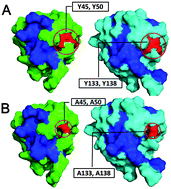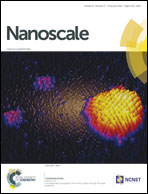Dissecting the contributions of β-hairpin tyrosine pairs to the folding and stability of long-lived human γD-crystallins†
Abstract
Ultraviolet-radiation-induced damage to and aggregation of human lens crystallin proteins are thought to be a significant pathway to age-related cataract. The aromatic residues within the duplicated Greek key domains of γ- and β-crystallins are the main ultraviolet absorbers and are susceptible to direct and indirect ultraviolet damage. The previous site-directed mutagenesis studies have revealed a striking difference for two highly conserved homologous β-hairpin Tyr pairs, at the N-terminal domain (N-td) and C-terminal domain (C-td), respectively, in their contribution to the overall stability of HγD-Crys, but why they behave so differently still remains a mystery. In this paper, we systematically investigated the underlying molecular mechanism and detailed contributions of these two Tyr pairs with large scale molecular dynamics simulations. A series of different tyrosine-to-alanine pair(s) substitutions were performed in either the N-td, the C-td, or both. Our results suggest that the Y45A/Y50A pair substitution in the N-td mainly affects the stability of the N-td itself, while the Y133A/Y138A pair substitution in the C-td leads to a more cooperative unfolding of both N-td and C-td. The stability of motif 2 in the N-td is mainly determined by the interdomain interface, while motif 1 in the N-td or motifs 3 and 4 in the C-td are mainly stabilized by the intradomain hydrophobic core. The damage to any tyrosine pair(s) can directly introduce some apparent water leakage to the hydrophobic core at the interface, which in turn causes a serious loss in the stability of the N-td. However, for the C-td substitutions, it may further impair the stable “sandwich-like” Y133-R167-Y138 cluster (through cation–π interactions) in the wild-type, thus causing the loop regions near the residue A138 to undergo large fluctuations, which in turn results in the intrusion of water into the hydrophobic core of the C-td and induces the C-td to lose its stability. These findings help resolve the “mystery” on why these two Tyr pairs display such a striking difference in their contributions to the overall protein stability despite their highly homologous nature.


 Please wait while we load your content...
Please wait while we load your content...